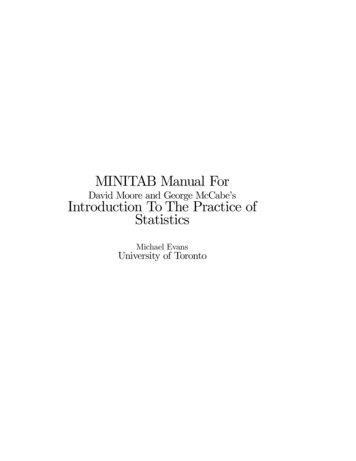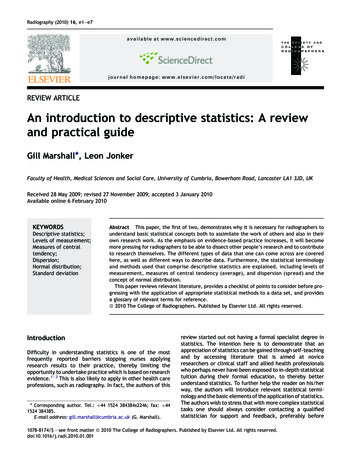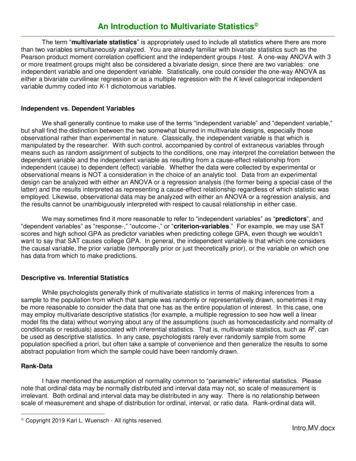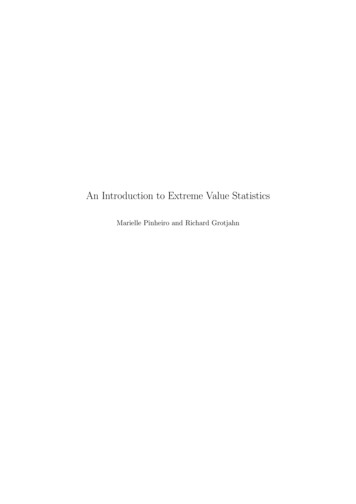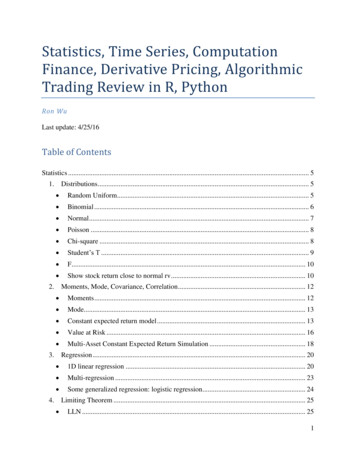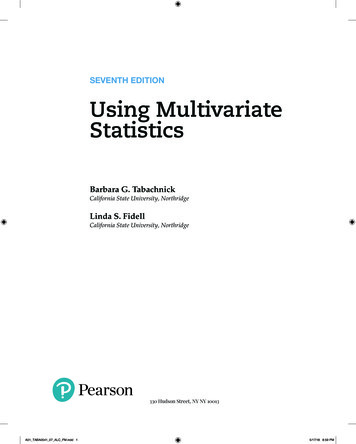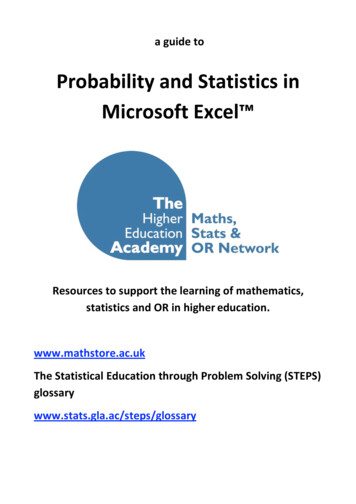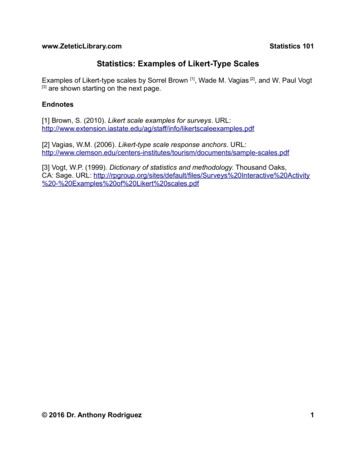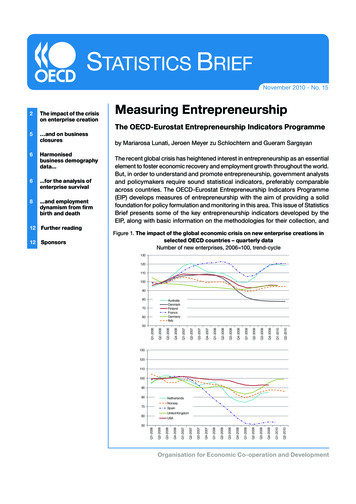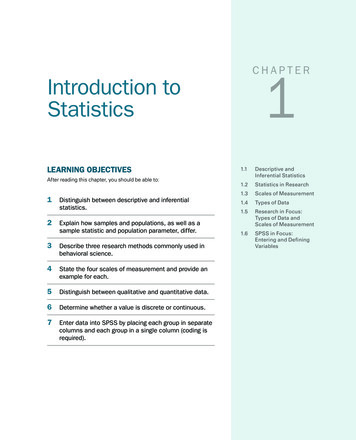
Transcription
CHAPTER1Introduction toStatisticsLEARNING OBJECTIVESAfter reading this chapter, you should be able to:12Distinguish between descriptive and inferentialstatistics.Explain how samples and populations, as well as asample statistic and population parameter, differ.3Describe three research methods commonly used inbehavioral science.4State the four scales of measurement and provide anexample for each.5Distinguish between qualitative and quantitative data.6Determine whether a value is discrete or continuous.7Enter data into SPSS by placing each group in separatecolumns and each group in a single column (coding isrequired).1.1Descriptive andInferential Statistics1.2Statistics in Research1.3Scales of Measurement1.4Types of Data1.5Research in Focus:Types of Data andScales of Measurement1.6SPSS in Focus:Entering and DefiningVariables
21.1PART I: INTRODUCTION AND DESCRIPTIVE STATISTICSDESCRIPTIVE AND INFERENTIAL STATISTICSWhy should you study statistics? The topic can be intimidating, and rarely doesanyone tell you, “Oh, that’s an easy course . . . take statistics!” Statistics is abranch of mathematics used to summarize, analyze, and interpret what weobserve—to make sense or meaning of our observations. A family counselor mayuse statistics to describe patient behavior and the effectiveness of a treatmentprogram. A social psychologist may use statistics to summarize peer pressureamong teenagers and interpret the causes. A college professor may give studentsa survey to summarize and interpret how much they like (or dislike) the course.In each case, the counselor, psychologist, and professor make use of statistics todo their job.The reason it is important to study statistics can be described by the words ofMark Twain: “There are lies, damned lies and statistics.” He meant that statistics canbe deceiving—and so can interpreting them. Statistics are all around you—fromyour college grade point average (GPA) to a Newsweek poll predicting which political candidate is likely to win an election. In each case, statistics are used to informyou. The challenge as you move into your careers is to be able to identify statisticsand to interpret what they mean. Statistics are part of your everyday life, and theyare subject to interpretation. The interpreter, of course, is YOU.DEFINITIONStatistics is a branch of mathematics used to summarize, analyze, andinterpret a group of numbers or observations.We begin by introducing two general types of statistics: Descriptive statistics: statistics that summarize observations. Inferential statistics: statistics used to interpret the meaning of descriptivestatistics.This book describes how to apply and interpret both types of statistics in science and in practice to make you a more informed interpreter of the statisticalinformation you encounter inside and outside of the classroom. Figure 1.1 is a schematic diagram of the chapter organization of this book, showing which chaptersfocus on descriptive statistics and which focus on inferential statistics.DESCRIPTIVE STATISTICSResearchers can measure many behavioral variables, such as love, anxiety, memory, and thought. Often, hundreds or thousands of measurements are made, andprocedures were developed to organize, summarize, and make sense of these measures. These procedures, referred to as descriptive statistics, are specifically usedto describe or summarize numeric observations, referred to as data. To illustrate,suppose we want to study anxiety among college students. We could describe anxiety, then, as a state or feeling of worry and nervousness. This certainly describesanxiety, but not numerically (or in a way that allows us to measure anxiety).Instead, we could state that anxiety is the number of times students fidget during aclass presentation. Now anxiety is defined as a number. We may observe 50, 100,or 1,000 students give a class presentation and record the number of times each
C H APT ER 1 : I N T RO D U C T I O N T O S TAT I S T I C S3Transition fromdescriptive toinferential statistics(Chapters 6-7)Inferential Statistics(Chapters 8-18)Descriptive Statistics(Chapters 2-5)FIGURE 1.1StatisticsA general overview of this book.This book begins with anintroduction to descriptivestatistics (Chapters 2–5) and thenuses descriptive statistics totransition (Chapters 6–7) to adiscussion of inferential statistics(Chapters 8–18).student fidgeted. Presenting a spreadsheet with the number for each individualstudent is not very clear. For this reason, researchers use descriptive statistics tosummarize sets of individual measurements so they can be clearly presented andinterpreted.Descriptive statistics are procedures used to summarize, organize, and makesense of a set of scores or observations.Descriptive statistics are typically presented graphically, in tabular form(in tables), or as summary statistics (single values).DEFINITIONData (plural) are measurements or observations that are typically numeric.A datum (singular) is a single measurement or observation, usually referred toas a score or raw score.Data are generally presented in summary. Typically, this means that data arepresented graphically, in tabular form (in tables), or as summary statistics (e.g., anaverage). For example, the number of times each individual fidgeted is not all thatmeaningful, whereas the average (mean), middle (median), or most common(mode) number of times among all individuals is more meaningful. Tables andgraphs serve a similar purpose to summarize large and small sets of data.Most often, researchers collect data from a portion of individuals in a group ofinterest. For example, the 50, 100, or 1,000 students in the anxiety example wouldnot constitute all students in college. Hence, these researchers collected anxietydata from some students, not all. So researchers require statistical procedures thatallow them to infer what the effects of anxiety are among all students of interestusing only the portion of data they measured.NOTE: Descriptive statisticssummarize data to make senseor meaning of a list of numericvalues.
4PART I: INTRODUCTION AND DESCRIPTIVE STATISTICSINFERENTIAL STATISTICSThe problem described in the last paragraph is that most scientists have limitedaccess to the phenomena they study, especially behavioral phenomena. As a result,researchers use procedures that allow them to interpret or infer the meaning ofdata. These procedures are called inferential statistics.DEFINITIONInferential statistics are procedures used that allow researchers to infer orgeneralize observations made with samples to the larger population fromwhich they were selected.To illustrate, let’s continue with the college student anxiety example. Allstudents enrolled in college would constitute the population. This is thegroup that researchers want to learn more about. Specifically, they want to learnmore about characteristics in this population, called population parameters.The characteristics of interest are typically some descriptive statistic. In the anxiety example, the characteristic of interest is anxiety, specifically measured asthe number of times students fidget during a class presentation.Unfortunately, in behavioral research, scientists rarely know what these population parameters are since they rarely have access to an entire population. Theysimply do not have the time, money, or other resources to even consider studyingall students enrolled in college.DEFINITIONA population is defined as the set of all individuals, items, or data of interest.This is the group about which scientists will generalize.A characteristic (usually numeric) that describes a population is referred to as apopulation parameter.NOTE: Inferentialstatistics are used to helpthe researcher infer howwell statistics in asample reflectparameters in apopulation.DEFINITIONThe alternative is to select a portion or sample of individuals in the population. Selecting a sample is more practical, and most scientific research you readcomes from samples and not populations. Going back to our example, this meansthat selecting a portion of students from the larger population of all studentsenrolled in college would constitute a sample. A characteristic that describes asample is called a sample statistic—this is similar to a parameter, except itdescribes characteristics in a sample and not a population. Inferential statisticsuse the characteristics in a sample to infer what the unknown parameters arein a given population. In this way, as shown in Figure 1.2, a sample is selectedfrom a population to learn more about the characteristics in the population ofinterest.A sample is defined as a set of selected individuals, items, or data taken froma population of interest.A characteristic (usually numeric) that describes a sample is referred to as asample statistic.
C H APT ER 1 : I N T RO D U C T I O N T O S TAT I S T I C S5Population: All studentsenrolled in college.Sample: 50 students 100 students 1,000 studentsDraw conclusions aboutanxiety levels for theentire population ofstudents (not just amongthose in each sample).Observe the number of times eachstudent fidgets during a classpresentation in each sample.MAKING SENSE: Populations and SamplesA population is identified as any group of interest, whether that group is allstudents worldwide or all students in a professor’s class. Think of any groupyou are interested in. Maybe you want to understand why college studentsjoin fraternities and sororities. So students who join fraternities and sororitiesis the group you’re interested in. Hence, this group is now a population ofinterest, to you anyways. You identified a population of interest just asresearchers identify populations they are interested in.Remember that researchers collect samples only because they do not haveaccess to all individuals in a population. Imagine having to identify every person who has fallen in love, experienced anxiety, been attracted to someoneelse, suffered with depression, or taken a college exam. It’s ridiculous to consider that we can identify all individuals in such populations. So researchersuse data gathered from samples (a portion of individuals from the population)to make inferences concerning a population.To make sense of this, say you want to get an idea of how people in general feel about a new pair of shoes you just bought. To find out, you put yournew shoes on and ask 20 people at random throughout the day whether or notthey like the shoes. Now, do you really care about the opinion of only those20 people you asked? Not really—you actually care more about the opinion ofpeople in general. In other words, you only asked the 20 people (your sample)to get an idea of the opinions of people in general (the population of interest).Sampling from populations follows a similar logic.FIGURE 1.2Samples and populations. In thisexample, levels of anxiety weremeasured in a sample of 50, 100,or 1,000 college students.Researchers will observe anxietyin each sample. Then they will useinferential statistics to generalizetheir observations in each sampleto the larger population, fromwhich each sample was selected.
6PART I: INTRODUCTION AND DESCRIPTIVE STATISTICSE X A M PL E 1.1On the basis of the following example, we will identify the population, sample,population parameter, and sample statistic: Suppose you read an article in the localcollege newspaper citing that the average college student plays 2 hours of videogames per week. To test whether this is true for your school, you randomly approach20 fellow students and ask them how long (in hours) they play video games perweek. You find that the average student, among those you asked, plays video gamesfor 1 hour per week. Distinguish the population from the sample.In this example, all college students at your school constitute the population ofinterest, and the 20 students you approached is the sample that was selected fromthis population of interest. Since it is purported that the average college studentplays 2 hours of video games per week, this is the population parameter (2 hours).The average number of hours playing video games in the sample is the samplestatistic (1 hour).LE A R N I N GC H EC K 11.are techniques used to summarize or describe numeric data.2.describe(s) how a population is characterized, whereasdescribe(s) the characteristics of samples.a. Statistics; parametersb. Parameters; statisticsc. Descriptive; inferentiald. Inferential; descriptive3.A psychologist wants to study a small population of 40 students in a local private school. If the researcher was interested in selecting the entire population ofstudents for this study, then how many students must the psychologist include?a. None, since it is not possible to study an entire population in this case.b. At least half, since this would constitute the majority of the population.c. All 40 students, since all students constitute the population.4.True or false: Inferential statistics are used to help the researcher infer whetherobservations made with samples are reflective of the population.Answers: 1. Descriptive statistics; 2. B; 3. C; 4. True.1.2STATISTICS IN RESEARCHThis book will describe many ways of measuring and interpreting data. Yet, simplycollecting data does not make you a scientist. To engage in science, you must followspecific procedures for collecting data. Think of this as playing a game. Without therules and procedures for playing, the game itself would be lost. The same is true inscience; without the rules and procedures for collecting data, the ability to drawscientific conclusions would be lost. Ultimately, statistics are used in the context ofscience, and so it is necessary to introduce you to the basic procedures of scientificinquiry.
C H APT ER 1 : I N T RO D U C T I O N T O S TAT I S T I C STo illustrate the basic premise of engaging in science, suppose you come across thefollowing problem first noted by the famous psychologist Edward Thorndike in 1898:Dogs get lost hundreds of times and no one ever notices it or sends anaccount of it to a scientific magazine, but let one find his way fromBrooklyn to Yonkers and the fact immediately becomes a circulating anecdote. Thousands of cats on thousands of occasions sit helplessly yowling,and no one takes thought of it or writes to his friend, the professor; but letone cat claw at the knob of a door supposedly as a signal to be let out, andstraightway this cat becomes the representative of the cat-mind in allbooks. . . . In short, the anecdotes give really . . . supernormal psychology ofanimals. (pp. 4–5)Science is the study of phenomena, such as behavior, through strictobservation, evaluation, interpretation, and theoretical explanation.DEFINITIONHere the problem was to determine the animal mind. Edward Thorndike posedthe question of whether animals were truly smart, based on the many observationshe made. This is where the scientific process typically begins—with a question. Toanswer questions in a scientific manner, researchers need more than just statistics;they need a set of strict procedures for making the observations and measurements.In this section, we introduce three research methods commonly used in behavioralresearch: experimental, quasi-experimental, and correlational methods. Eachresearch method involves examining the relationship between variables. Eachmethod is introduced here since we will apply these methods throughout the book.EXPERIMENTAL METHODAny study that demonstrates cause is called an experiment. To demonstrate cause,though, an experiment must follow strict procedures to ensure that the possibilityof all other possible causes have been minimized or eliminated. So researchers mustcontrol the conditions under which observations are made to isolate cause-andeffect relationships between variables. Figure 1.3 shows the steps in a typical experiment based on a sample taken from a population. We will work through thisexample to describe the basic structure of an experiment.To conduct an experiment, a researcher must specifically control theconditions under which observations are made to isolate cause-and-effectrelationships between variables.Three requirements must be satisfied for a study to be regarded as anexperiment: randomization, manipulation, and comparison.The experiment illustrated in Figure 1.3 was designed to determine the effect ofdistraction on student test scores. A sample of students was selected from a population of all undergraduates. In one group, the professor sat quietly while studentstook the exam (low-distraction group); in the other, the professor rattled papers,tapped her foot, and made other sounds during the exam (high-distraction group).Exam scores in both groups were measured and compared.For this study to be called an experiment, researchers must satisfy three requirements. These requirements are regarded as the necessary steps to ensure enoughDEFINITION7
8PART I: INTRODUCTION AND DESCRIPTIVE STATISTICSPopulationFIGURE 1.3The basic structure of anexperiment that meets eachrequirement for demonstratingcause-and-effect: randomization,manipulation, and comparison. Inthis example, a random sample ofstudents was selected from apopulation of all undergraduatesto study the effects of distractionon exam performance. To qualifyas an experiment, (1) studentswere randomly assigned toexperience a low- or highdistraction condition while takingan exam (randomization), (2) theresearcher created each level ofdistraction (manipulation), and (3)a comparison group was includedwhere distraction was minimal orabsent (comparison).SampleManipulate one variable—randomly assignparticipants to each level ofthe manipulated variable.Example: Randomlyassign participants to twolevels of distraction.Low-distraction condition:A professor sits quietly ata desk while students takean exam.High-distraction condition:A professor makes loudsounds (paper ruffling,foot tapping) at a desk whilestudents take an exam.Measure grades onexam (0–100 points).Measure grades onexam (0–100 points).Measure a second variable—the same variable is measuredin each condition, and thedifference between groupsis compared.Example: Measure examperformance (or grades)in each condition.control to allow researchers to draw cause-and-effect conclusions. These requirements are the following:1. Randomization (of assigning participants to conditions)2. Manipulation (of variables that operate in an experiment)3. Comparison (or a control group)To meet the requirement of randomization, researchers must use randomassignment (Requirement 1) to assign participants to groups. To do this, aresearcher must be able to manipulate the levels of an independent variable(IV) (Requirement 2) to create the groups. Referring back to the test distractionexample shown in Figure 1.3, the independent variable was distraction. Theresearchers first manipulated the levels of this variable (low, high), meaning thatthey created the conditions. They then assigned each student at random to experience one of the levels of distraction.DEFINITIONRandom assignment is a random procedure used to ensure that participants ina study have an equal chance of being assigned to a particular group or condition.An independent variable (IV) is the variable that is manipulated in anexperiment. This variable remains unchanged (or “independent”) betweenconditions being observed in an experiment. It is the “presumed cause.”The specific conditions of an IV are referred to as the levels of the IV.Random assignment and manipulation ensure that characteristics of participants in each group (such as their age, intelligence level, or study habits) varyentirely by chance. Since participant characteristics between groups now occur at
C H APT ER 1 : I N T RO D U C T I O N T O S TAT I S T I C Srandom, we can assume that these characteristics are about the same betweengroups. This makes it more likely that any differences observed between groupswere caused by the manipulation (low vs. high levels of distraction) and not participant characteristics.Notice also that there are two groups in the experiment shown in Figure 1.3. Sotests scores for students experiencing high levels of distraction were compared tothose experiencing low levels of distraction. By comparing test scores betweengroups, we can determine whether high levels of distraction caused lower scores(compared to scores in the low-distraction group). This satisfies the requirement ofcomparison (Requirement 3), which requires that at least two groups be observed inan experiment. This allows scores in one group to be compared to those in at leastone other group.In this example, test scores were measured in each group. The measured variable in an experiment is referred to as the dependent variable (DV). Dependentvariables can often be measured in many ways, and therefore require an operational definition. This is where a dependent variable is defined in terms of howit will be measured. For example, here we operationally defined exam performance asa score between 0 and 100 on a test. So to summarize the experiment in Figure 1.3,levels of distraction (IV) were presumed to cause an effect or difference in examgrades (DV) between groups. This is an experiment since the researchers satisfiedthe requirements of randomization, manipulation, and comparison, thereby allowing them to draw cause-and-effect conclusions.The dependent variable (DV) is the variable that is believed to change in thepresence of the independent variable. It is the “presumed effect.”9NOTE: An experiment is onewhere researchers satisfy threerequirements to ensure enoughcontrol to allow researchers todraw cause-and-effectconclusions. These arerandomization, manipulation,and comparison.DEFINITIONAn operational definition is a description of some observable event in termsof the specific process or manner by which it was observed or measured.QUASI-EXPERIMENTAL METHODA study that lacks randomization, manipulation, or comparison is called aquasi-experiment. This most often occurs in one of two ways:1. The study includes a quasi-independent variable.2. The study lacks a comparison group.In a typical quasi-experiment, the variables being studied can’t be manipulated,which makes random assignment impossible. This occurs when variables are preexisting or inherent to the participants themselves. These types of variables are calledquasi-independent variables. Figure 1.4 shows an example of a quasi-experimentthat measured differences in multitasking ability by gender. Since the levels ofgender (male, female) can’t be randomly assigned (it is a quasi-independentvariable), this study is regarded as a quasi-experiment.A quasi-independent variable is a variable whose levels are not randomlyassigned to participants (nonrandom). This variable differentiates the groups orconditions being compared in a quasi-experiment.DEFINITIONNOTE: A quasi-experiment isA study is also regarded as a quasi-experiment when only one group isobserved. Since only one group is observed, there is no comparison group. So differences between two levels of an independent variable can’t be compared. In thisa study that (1) includes aquasi-independent variable or(2) lacks a comparison group.
10PART I: INTRODUCTION AND DESCRIPTIVE STATISTICSGender is not randomlyassigned. Men areassigned to the malecondition; women to thefemale condition.A sample of men and womenis selected from a population.FIGURE 1.4The basic structure of a quasiexperiment. In this example,researchers measured differencesin multitasking behavior by gender.The grouping variable (gender) ispreexisting. That is, participantswere already male or female priorto the study. For this reason,researchers can’t manipulate thevariable or randomly assignparticipants to each level ofgender, so this study is regardedas a quasi-experiment.Male condition:Men are asked to completeas many tasks as possiblein 5 minutes.Female condition:Women are asked to completeas many tasks as possiblein 5 minutes.Dependent measure:The number of taskscompleted is recorded.Dependent measure:The number of taskscompleted is recorded.way, failing to satisfy any of the three requirements for an experiment (randomization, manipulation, or comparison) makes the study a quasi-experiment.CORRELATIONAL METHODNOTE: The correlationalmethod involves measuringthe relationship between pairsof scores.E X A M PL E 1. 2Another method for examining the relationship between variables is to measure pairsof scores for each individual. This method can determine whether a relationshipexists between variables, but it lacks the appropriate control needed to demonstratecause and effect. To illustrate, suppose you test for a relationship between time spentusing a computer and exercising per week. The data for such a study appear in tabularform and plotted as a graph in Figure 1.5. Using the correlational method, we canexamine the extent to which two variables change in a related fashion. In the example shown in Figure 1.5, as computer use increases, time spent exercising decreases.This pattern suggests that computer use and time spent exercising are related.Notice that no variable is manipulated to create different conditions or groupsto which participants can be randomly assigned. Instead, two variables are measuredfor each participant, and the extent to which those variables are related is measured.This book will describe many statistical procedures used to analyze data using thecorrelational method (Chapters 15–17) and the experimental and quasi-experimental methods (Chapters 9–14, 17–18).A researcher conducts the following study: Participants are presented with a list ofwords written on a white background on a PowerPoint slide. In one group, thewords are written in red (Group Color); in a second group, the words are written inblack (Group Black). Participants are allowed to study the words for 1 minute. Afterthat time, the slide is removed and participants are allowed 1 minute to write downas many words as they can recall. The number of words correctly recalled will berecorded for each group. Explain how this study can be an experiment.
C H APT ER 1 : I N T RO D U C T I O N T O S TAT I S T I C S(a)(b)ParticipantComputer use(Hours per week)Exercise(Minutes per week)A380B283C096D1060E878F124611120FIGURE 1.5Exercise(Minutes per week)10080604020002468101214Computer Use (Hours per week)To create an experiment, we must satisfy the three requirements for demonstratingcause and effect: randomization, manipulation, and comparison. To satisfy eachrequirement, the researcher can1. Randomly assign participants to experience one of the conditions. Thisensures that some participants read colored words and others read blackwords entirely by chance.2. Create the two conditions. The researcher could write 20 words on aPowerPoint slide. On one slide, the words are written in red; on the secondslide, the same words are written in black.3. Include a comparison group. In this case, the number of colored words correctly recalled will be compared to the number of black words correctlyrecalled, so this study has a comparison group.Remember that each requirement is necessary to demonstrate that the levels of anindependent variable are causing changes in the value of a dependent variable. Ifany one of these requirements is not satisfied, then the study is not an experiment.An example of the correlationalmethod. In this example,researchers measured the amountof time students spent using thecomputer and exercising eachweek. (A) The table shows twosets of scores for each participant.(B) The graph shows the pattern ofthe relationship between thesescores. From the data, we can seethat the two variables (computeruse and exercise) change in arelated fashion. That is, ascomputer use increases, timespent exercising decreases.
12PART I: INTRODUCTION AND DESCRIPTIVE STATISTICSLE A R N I N GC H EC K 21.is the study of phenomena through strict observation, evaluation,interpretation, and theoretical explanation.2.State whether each of the following describes an experiment, quasi-experiment,or correlational method.a. A researcher tests whether dosage level of some drug (low, high) causessignificant differences in health.b. A researcher tests whether political affiliation (Republican, Democrat) isassociated with different attitudes toward morality.c. A researcher measures the relationship between income and life satisfaction.3.True or false: An experiment is the only method that can demonstrate causeand-effect relationships between variables.Answers: 1. Science; 2. A. Experiment. B. Quasi-experiment. C. Correlational method; 3. True.1.3SCALES OF MEASUREMENTMany statistical tests introduced in this book will require that variables in a studybe measured on a certain scale of measurement. In the early 1940s, Harvard psychologist S. S. Stevens coined the terms nominal, ordinal, interval, and ratio to classifythe scales of measurement (Stevens, 1946). Scales of measurement are rules thatdescribe the properties of numbers. These rules imply that a number is not just anumber in science. Instead, the extent to which a number is informative dependson how it was used or measured. In this section, we discuss the extent to which dataare informative. In all, scales of measurement are characterized by three properties:order, differences, and ratios. Each property can be described by answering the following questions:1. Order: Does a larger number indicate a greater value than a smaller number?2. Differences: Does subtracting two numbers represent some meaningfulvalue?3. Ratio: Does dividing (or taking the ratio of) two numbers represent somemeaningful value?DEFINITIONScales of measurement refer to how the properties of numbers can changewith different uses.Table 1.1 summarizes the answers to the questions for each scale of measurement. You can think of each scale as a gradient of the informativeness of data. Inthis section, we begin with the leas
Statistics are part of your everyday life, and they are subject to interpretation. The interpreter, of course, is YOU. Statistics is a branch of mathematics used to summarize, analyze, and interpret a group of numbers or observations. We begin by intr
